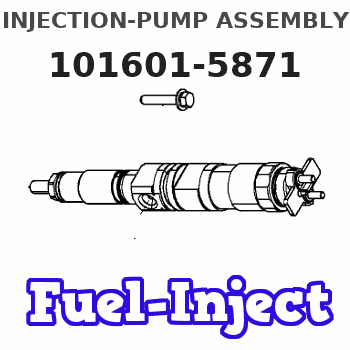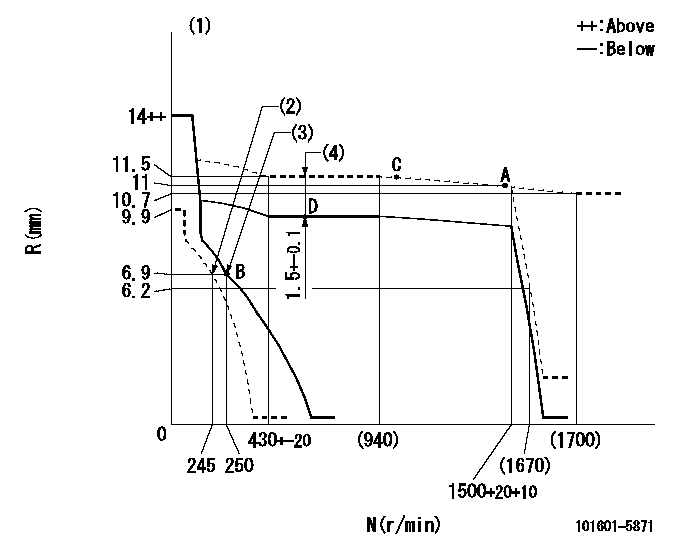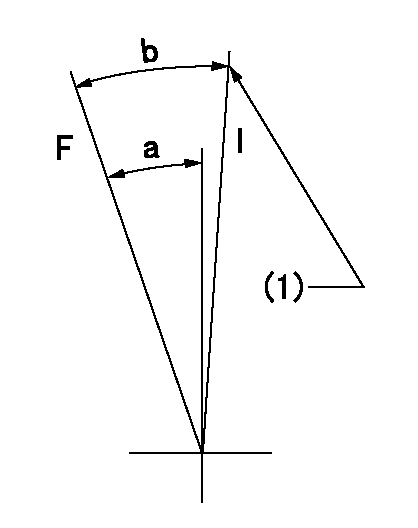Information injection-pump assembly
ZEXEL
101601-5871
1016015871
HINO
220203752A
220203752a

Rating:
Service parts 101601-5871 INJECTION-PUMP ASSEMBLY:
1.
_
6.
COUPLING PLATE
7.
COUPLING PLATE
8.
_
9.
_
11.
Nozzle and Holder
23600-2460A
12.
Open Pre:MPa(Kqf/cm2)
18.1{185}
15.
NOZZLE SET
Include in #1:
101601-5871
as INJECTION-PUMP ASSEMBLY
Include in #2:
104139-4002
as _
Cross reference number
ZEXEL
101601-5871
1016015871
HINO
220203752A
220203752a
Zexel num
Bosch num
Firm num
Name
Calibration Data:
Adjustment conditions
Test oil
1404 Test oil ISO4113 or {SAEJ967d}
1404 Test oil ISO4113 or {SAEJ967d}
Test oil temperature
degC
40
40
45
Nozzle and nozzle holder
105780-8140
Bosch type code
EF8511/9A
Nozzle
105780-0000
Bosch type code
DN12SD12T
Nozzle holder
105780-2080
Bosch type code
EF8511/9
Opening pressure
MPa
17.2
Opening pressure
kgf/cm2
175
Injection pipe
Outer diameter - inner diameter - length (mm) mm 6-2-600
Outer diameter - inner diameter - length (mm) mm 6-2-600
Overflow valve
131424-6420
Overflow valve opening pressure
kPa
255
221
289
Overflow valve opening pressure
kgf/cm2
2.6
2.25
2.95
Tester oil delivery pressure
kPa
157
157
157
Tester oil delivery pressure
kgf/cm2
1.6
1.6
1.6
Direction of rotation (viewed from drive side)
Right R
Right R
Injection timing adjustment
Direction of rotation (viewed from drive side)
Right R
Right R
Injection order
1-4-2-6-
3-5
Pre-stroke
mm
4.4
4.35
4.45
Beginning of injection position
Drive side NO.1
Drive side NO.1
Difference between angles 1
Cal 1-4 deg. 60 59.5 60.5
Cal 1-4 deg. 60 59.5 60.5
Difference between angles 2
Cyl.1-2 deg. 120 119.5 120.5
Cyl.1-2 deg. 120 119.5 120.5
Difference between angles 3
Cal 1-6 deg. 180 179.5 180.5
Cal 1-6 deg. 180 179.5 180.5
Difference between angles 4
Cal 1-3 deg. 240 239.5 240.5
Cal 1-3 deg. 240 239.5 240.5
Difference between angles 5
Cal 1-5 deg. 300 299.5 300.5
Cal 1-5 deg. 300 299.5 300.5
Injection quantity adjustment
Adjusting point
A
Rack position
11
Pump speed
r/min
1500
1500
1500
Average injection quantity
mm3/st.
102.6
100.6
104.6
Max. variation between cylinders
%
0
-3
3
Basic
*
Fixing the lever
*
Boost pressure
kPa
50.7
50.7
Boost pressure
mmHg
380
380
Injection quantity adjustment_02
Adjusting point
B
Rack position
6.9+-0.5
Pump speed
r/min
250
250
250
Average injection quantity
mm3/st.
12
10.5
13.5
Max. variation between cylinders
%
0
-15
15
Fixing the rack
*
Boost pressure
kPa
0
0
0
Boost pressure
mmHg
0
0
0
Boost compensator adjustment
Pump speed
r/min
600
600
600
Rack position
10
Boost pressure
kPa
4
1.3
6.7
Boost pressure
mmHg
30
10
50
Boost compensator adjustment_02
Pump speed
r/min
600
600
600
Rack position
11.5
Boost pressure
kPa
37.3
30.6
44
Boost pressure
mmHg
280
230
330
Timer adjustment
Pump speed
r/min
1350--
Advance angle
deg.
0
0
0
Remarks
Start
Start
Timer adjustment_02
Pump speed
r/min
1300
Advance angle
deg.
0.3
Timer adjustment_03
Pump speed
r/min
1500
Advance angle
deg.
1.5
1.2
1.8
Remarks
Finish
Finish
Test data Ex:
Governor adjustment

N:Pump speed
R:Rack position (mm)
(1)Notch fixed: K
(2)Set idle sub-spring
(3)Main spring setting
(4)Boost compensator stroke (at N = N1)
----------
K=17 N1=600r/min
----------
----------
K=17 N1=600r/min
----------
Speed control lever angle

F:Full speed
I:Idle
(1)Stopper bolt setting
----------
----------
a=(21deg)+-5deg b=(28deg)+-5deg
----------
----------
a=(21deg)+-5deg b=(28deg)+-5deg
Stop lever angle

N:Pump normal
S:Stop the pump.
(1)Pump speed aa and rack position bb (to be sealed at delivery)
----------
aa=0r/min bb=1-0.2mm
----------
a=21deg+-5deg b=(55deg)
----------
aa=0r/min bb=1-0.2mm
----------
a=21deg+-5deg b=(55deg)
Timing setting

(1)Pump vertical direction
(2)Position of gear's standard threaded hole at No 1 cylinder's beginning of injection
(3)-
(4)-
----------
----------
a=(70deg)
----------
----------
a=(70deg)
Information:
Refer to the 3408 and 3412 Industrial Engine Troubleshooting Manual for more information.Below 12°C (55°F)
Caterpillar engines are designed to start at temperatures above 12°C (55°F) without using starting aids. If the temperature is below 12°C (55°F), a cylinder block coolant heater may be needed or crankcase oil may need to be heated.At temperatures below 0°C (32°F), it may be necessary to spray starting fluid into the air cleaner inlet. Additional injections of ether may be required to start and/or achieve low idle speed.
When using starting fluid, follow the manufacturer's instructions carefully, use it sparingly and spray it only while cranking the engine. Failure to do so, could result in an explosion and/or fire and possible personal injury.
Excessive ether can cause piston and ring damage. Use ether for cold starting purposes only. Do not use excessive starting fluid during starting or after the engine is running.
* Depress ether aid switch (if equipped with ether injection) and hold for three seconds, then release before performing step 3 above.* Begin cranking engine and depress ether switch and hold for three seconds then release. Additional injections of ether may be required to start and/or achieve low idle speed.The engine will run at low idle and will run smoothly as the electronic control system gradually increases the fuel flow to high idle in the Cold Mode procedure. Low Idle rpm - 600 - 750, Cold Mode rpm - 900 - 1000.Allow white smoke to clear up and proceed with normal operation.For starting below -18°C (0°F), use of optional cold weather starting aids are recommended. A jacket water heater or fuel heater may be required. Consult your Caterpillar dealer for additional information.Starting From External Electrical Source
Make initial determination as to failure of engine to crank. Refer to special instruction SEHS7768 on use of 6V2150 Starting/Charging Analyzer Group.If the installation is not equipped with a back-up battery system, then it may be necessary to start the engine from an external electrical source.Many batteries thought to be unusable, are still rechargeable. Severely discharged maintenance free batteries might not fully recharge from the alternator alone after jump starting. The batteries must be charged to the proper voltage with a battery charger. Refer to Special Instruction, SEHS7633, Battery Test Procedure, available from your Caterpillar dealer, for complete testing and charging information.
Be sure the main power switch is in the OFF position before attaching the booster cables to the engine being started. Turn OFF all electrical accessories.When boost starting an engine, follow the instructions to properly start the engine. This engine is equipped with a 24 volt starting system. Use only equal voltage for boost starting. The use of a welder or higher voltage will damage the electrical system and is not recommended.Do not allow the free ends of jumper cables to touch the engine. This helps avoid sparks. Do not reverse the battery cables. The alternator can be damaged. Attach ground cable last and remove first.
1. When using booster cables, be sure to connect in parallel: Connect
Caterpillar engines are designed to start at temperatures above 12°C (55°F) without using starting aids. If the temperature is below 12°C (55°F), a cylinder block coolant heater may be needed or crankcase oil may need to be heated.At temperatures below 0°C (32°F), it may be necessary to spray starting fluid into the air cleaner inlet. Additional injections of ether may be required to start and/or achieve low idle speed.
When using starting fluid, follow the manufacturer's instructions carefully, use it sparingly and spray it only while cranking the engine. Failure to do so, could result in an explosion and/or fire and possible personal injury.
Excessive ether can cause piston and ring damage. Use ether for cold starting purposes only. Do not use excessive starting fluid during starting or after the engine is running.
* Depress ether aid switch (if equipped with ether injection) and hold for three seconds, then release before performing step 3 above.* Begin cranking engine and depress ether switch and hold for three seconds then release. Additional injections of ether may be required to start and/or achieve low idle speed.The engine will run at low idle and will run smoothly as the electronic control system gradually increases the fuel flow to high idle in the Cold Mode procedure. Low Idle rpm - 600 - 750, Cold Mode rpm - 900 - 1000.Allow white smoke to clear up and proceed with normal operation.For starting below -18°C (0°F), use of optional cold weather starting aids are recommended. A jacket water heater or fuel heater may be required. Consult your Caterpillar dealer for additional information.Starting From External Electrical Source
Make initial determination as to failure of engine to crank. Refer to special instruction SEHS7768 on use of 6V2150 Starting/Charging Analyzer Group.If the installation is not equipped with a back-up battery system, then it may be necessary to start the engine from an external electrical source.Many batteries thought to be unusable, are still rechargeable. Severely discharged maintenance free batteries might not fully recharge from the alternator alone after jump starting. The batteries must be charged to the proper voltage with a battery charger. Refer to Special Instruction, SEHS7633, Battery Test Procedure, available from your Caterpillar dealer, for complete testing and charging information.
Be sure the main power switch is in the OFF position before attaching the booster cables to the engine being started. Turn OFF all electrical accessories.When boost starting an engine, follow the instructions to properly start the engine. This engine is equipped with a 24 volt starting system. Use only equal voltage for boost starting. The use of a welder or higher voltage will damage the electrical system and is not recommended.Do not allow the free ends of jumper cables to touch the engine. This helps avoid sparks. Do not reverse the battery cables. The alternator can be damaged. Attach ground cable last and remove first.
1. When using booster cables, be sure to connect in parallel: Connect